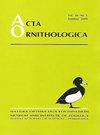Climate-Driven Range Shifts of the Sharp-Tailed Grouse Tympanuchus phasianellus
IF 1.3
4区 生物学
Q3 ORNITHOLOGY
引用次数: 6
Abstract
Abstract. In this study, we tested whether the Sharp-tailed Grouse Tympanuchus phasianellus experienced rapid demographic expansion and shifts in its distribution from the Last Glacial Maximum to the present and to the future. For this, we integrated two different approaches, phylogeography and ecological niche modeling, to understand the historical demography and the future of the Sharp-tailed Grouse under climate change scenarios. To this end, we re-analyzed two published mitochondrial DNA datasets to provide a comprehensive DNA characterization of populations across the range of this species. We used ecological niche models in tandem with landscape genetics to estimate the species current and historical geographic range, and to summarize effective connectivity among populations of the species at present. We found low genetic variation across the Sharp-tailed Grouse's distributions with almost no differentiation among subspecies. The haplotype network was consistent with star-shape topologies and showed no evident phylogeographic structure with the typical signature of recent demographic expansion. Taken together with the ecological niche modeling results, study outcomes supported the ‘expansion-contraction' model of Pleistocene biogeography. A unique result of this study was an apparently complete range shift of this species between the Last Glacial Maximum and the present, and a signature of cryptic refugium located in Alaskan territory in North America. The usual reason for lack of phylogeographic structure is broad dispersal, rapid expansion, and panmixia. However, in view of our novel geographic insights, a simpler explanation may be very recent establishment of the species’ range. The future predictions confirmed that the Sharp-tailed Grouse continues climate-driven range shifts in 2050 and 2070.气候驱动下的尖尾松鸡活动范围变化
摘要在这项研究中,我们测试了尖尾Grouse Tympanuchus phasianellus是否经历了人口的快速扩张,以及其分布从上一次冰川盛期到现在和未来的变化。为此,我们整合了两种不同的方法,系统地理学和生态位建模,以了解气候变化情景下尖尾Grouse的历史人口学和未来。为此,我们重新分析了两个已发表的线粒体DNA数据集,以提供该物种种群的全面DNA特征。我们使用生态位模型和景观遗传学来估计物种当前和历史的地理范围,并总结目前物种种群之间的有效连通性。我们发现尖尾Grouse分布的遗传变异很低,亚种之间几乎没有分化。单倍型网络与星形拓扑结构一致,没有显示出明显的系统地理学结构,具有最近人口扩张的典型特征。结合生态位建模结果,研究结果支持更新世生物地理学的“扩张-收缩”模型。这项研究的一个独特结果是,该物种在上一次冰川盛期和现在之间发生了明显的完全范围变化,并在北美洲阿拉斯加地区发现了神秘避难所的特征。缺乏系统地理结构的常见原因是广泛分布、快速扩张和泛混合。然而,鉴于我们新颖的地理见解,一个更简单的解释可能是最近建立的物种范围。未来的预测证实,尖尾Grouse在2050年和2070年继续发生气候驱动的范围变化。
本文章由计算机程序翻译,如有差异,请以英文原文为准。
求助全文
约1分钟内获得全文
求助全文
来源期刊

Acta Ornithologica
生物-鸟类学
CiteScore
2.10
自引率
0.00%
发文量
14
审稿时长
>12 weeks
期刊介绍:
Publishes scientific papers (original research reports, reviews, short notes, etc.) and announcements from all fields of ornithology. All manuscripts are peer-reviewed.
Established in 1933 as Acta Ornithologica Musei Zoologici Polonici, since 1953 continued under the present title.
Published twice a year by the Natura Optima Dux Foundation under the auspices of the Museum and Institute of Zoology, Polish Academy of Sciences.
 求助内容:
求助内容: 应助结果提醒方式:
应助结果提醒方式:


